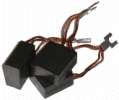Home » Mather + Platt » Motors
Electric motors
In the 1970's and 80's, Mather and Platt specialised in the low-volume manufacture of special purpose motors as well as medium-volume production of standard AC wound-rotor and squirrel-cage motors. In earlier days though, the main business was power generation and conversion with most rotating machines being of the open-framed type on large cast bedplates. More of this later.
Low Volume Manufacture
The low-volume motors were built to order and were typically manufactured in very small quantities, rarely exceeding perhaps 10 and frequently only one or two. These were for special duties in the oil industry, often running on 60Hz high voltage supplies, high-torque motors for steel mills and for various water pumping duties including sewage and flood water. In the case of small orders, there was often a spares component to the order, typically rotors though sometimes stators too. A high proportion of motors had wound rotors - this indicates their specific design for long start-up duties.
A very special motor was also manufactured for the polyethylene industry. This motor was used to stir the compressed ethylene gas under high pressure and temperature in its reaction vessel. The motors had a limited life span due to the onerous operating conditions. They didn't look like any conventional motor, with the usual foot mounting, connection box, ribs, fan cowl, etc. They looked like a smooth steel cylinder with no external fittings.
Medium Volume Manufacture
Medium-volume production covered standard ISO size motors in a variety of mountings (foot and flange) and types (totally enclosed, etc.). Mather and Platt never specialised in high-volume production of motors and left the production of all single phase motors and three phase motors under about 5hp to other companies such as Crompton, Metropolitan Vickers, etc. Manufacture was undertaken using the Flo-line technique where basic components were fed in at one end and complete motors emerged at the other. Wound rotor induction motors required more man-hours to make them than the more traditional squirrel-cage induction motors. Stators were always assembled by hand. Impregnation of the windings was done by dipping the stator into a bath of hot varnish before fitting it into its frame.
Many of the company's motors were made for the pump and fire-pump business, although other manufacturers' motors would be substituted if the customer requested. Fire pumps usually required no more than a few 10's of HP but the large high pressure/high flow pumps required motors capable of providing hundreds or thousands of HP.
Technical Innovation - Maploc
Following some technical difficulties with cracking of squirrel cage rotor bars near to where they were brazed to the short-circuit ring, Mather and Platt developed an improved method of fitting the rotor bars into the rotor laminations. The cracking was caused by there being insufficient flexibility in the rotor bar ends once they were driven into their slot. The new design involved fitting Spirol pins between the underside of the rotor bar and the bottom of its slot so that the rotor bar was not held so rigidly. The flexibility of the pins allowed the rotor bars to flex under the heavy loads imposed by starting thus avoiding cracking.
Earlier Machines
Early rotating machines were of the open-frame type, mounted on one or more bedplates and fixed to concrete plinths. Geared turbines were used extensively to drive AC or DC generators from 500kW to 2500kW capacity. The main advantage in AC installation was that the turbine could be run at much higher speed and could be designed more efficiently than if direct coupling was employed. For DC work there was the additional advantage that the generator could be designed on ordinary lines, avoiding the mechanical and commutation difficulties associated with high speeds. However, the disadvantage of using conventional speeds was that currents were higher and very long commutators, up to perhaps 4 feet long, had to be employed to deal with the high currents. In these situations, the brushgear usually had its own yoke which was separate from the generator yoke.


